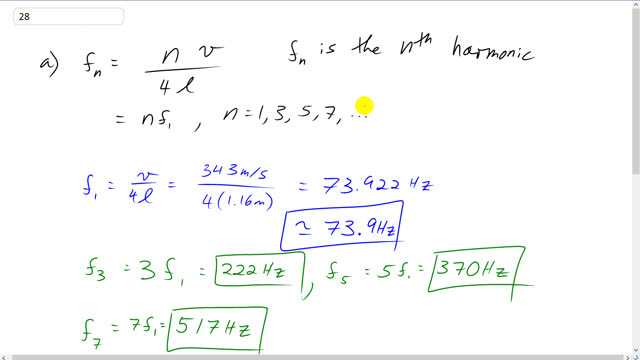
An organ pipe is 116 cm long. Determine the fundamental and first three audible overtones if the pipe is
- closed at one end, and
- open at both ends.

In order to watch this solution you need to have a subscription.
This is Giancoli Answers with Mr. Dychko. For a tube closed at one end, the nth harmonic is going to be some odd multiple of the fundamental. So, the second harmonic and the fourth harmonic that don't exist because that waveform won't fit into the tube closed at one end and the textbook has fairly good pictures to explain why because you need to have a displacement node at one end where it's closed and a displacement antinode at the end where it's open. So, first we'll figure out the fundamental, and that's going to be the wave speed which is the speed of sound divided by 4 times l. And in this case it's the speed of sound. Whereas in the question 27 for example this wave speed was a speed of the wave on the string itself. So, the speed of this v is the speed of the wave whatever wave is in the thing that's vibrating, in this case is a string, but in this case the thing is vibrating is the air within the tube and so the speed is going to be the speed of the wave that travels through air which is sound. And so that's why we have 343 here. So, 343 divided by 4 times 1.16 meters length of the closed in tube. And that gives about 73.9 hertz. And then we take this unrounded number and multiply it by 3 to get 222 hertz multiplied by 5 to get 370 hertz and then multiply it by 7 to get 517 hertz. And these are the first three overtones or the third, fifth and seventh harmonic. And then if we modeled this organ pipe as a open ended tube, open at both ends. Then we have the nth harmonic cause we're in the n times the fundamental where n is a natural number 1, 2, 3, 4 and so on. And it's... The fundamental is v over 2 l now instead of v over 4 l as it was before. So, the fundamental f1 is going to be 343 meters per second divided by 2 times 1.16. And that gives about 148 hertz and f2 the first overtone or the second harmonic is going to be 296 hertz and then multiply it by 3, the f, 444 hertz. And then multiply by 4 to get 591 hertz. And these are the first three overtones.